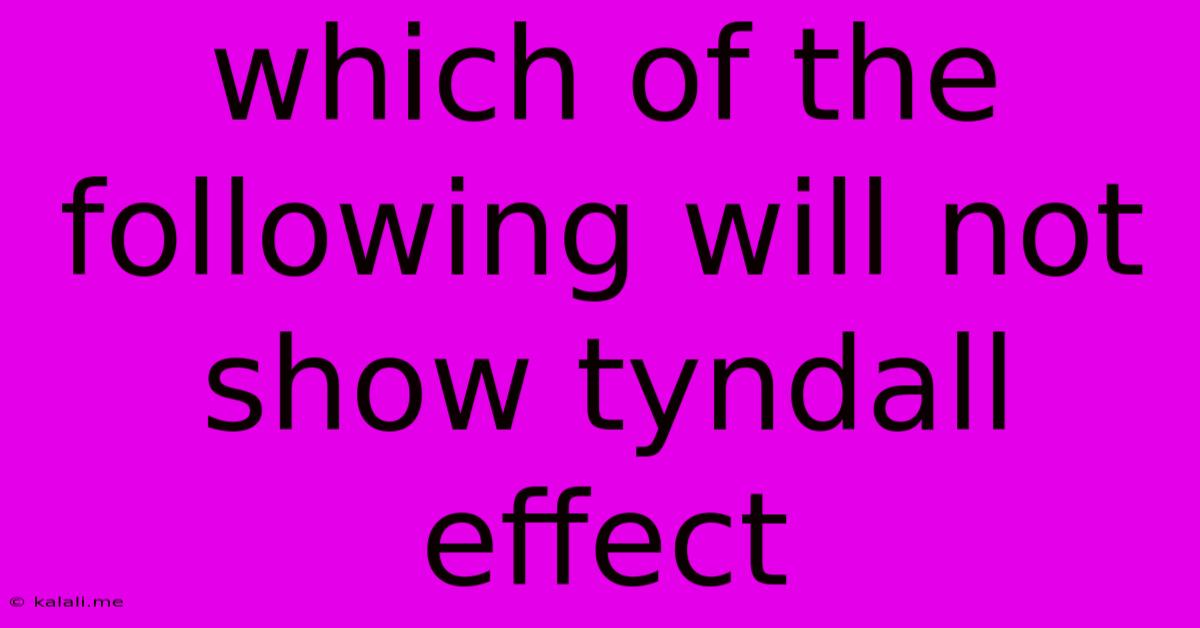Which Of The Following Will Not Show Tyndall Effect
Kalali
Jun 13, 2025 · 3 min read

Table of Contents
Which of the Following Will Not Show the Tyndall Effect? Understanding Colloid and Solution Differences
The Tyndall effect is a fascinating phenomenon where a beam of light becomes visible as it passes through a colloid. This scattering of light reveals the presence of tiny particles suspended in a medium, a characteristic that distinguishes colloids from true solutions. But which substances will not exhibit this effect? Understanding the difference between solutions and colloids is key to answering this. This article will delve into the scientific principles behind the Tyndall effect and explain why certain substances fail to demonstrate it.
What is the Tyndall Effect?
The Tyndall effect is the scattering of light as a light beam passes through a colloid. This scattering is caused by the interaction of light with the relatively large particles dispersed within the colloid. These particles are larger than the wavelength of visible light (generally considered to be 400-700 nanometers), causing them to scatter light in all directions. This makes the light beam visible.
Colloids vs. Solutions: The Crucial Difference
The key to understanding which substances will not show the Tyndall effect lies in distinguishing between colloids and solutions.
-
Solutions: In a true solution, the solute particles are extremely small—typically individual atoms, ions, or small molecules—and are completely dissolved in the solvent. Because these particles are much smaller than the wavelength of light, they do not scatter light significantly. Therefore, a beam of light passing through a solution will remain invisible. Examples include saltwater, sugar dissolved in water, and air.
-
Colloids: Colloids, on the other hand, contain dispersed particles that are significantly larger than those in a solution, ranging from 1 to 1000 nanometers. These particles are not dissolved but are suspended in the dispersing medium. This size difference is what allows them to scatter light, resulting in the observable Tyndall effect. Examples of colloids include milk, fog, and gelatin.
Substances That Will NOT Show the Tyndall Effect
Any substance that forms a true solution will not demonstrate the Tyndall effect. This is because the solute particles are too small to scatter visible light effectively. Examples include:
- Saltwater (NaCl in H₂O): The sodium and chloride ions are dissolved at the atomic level.
- Sugar water (Sucrose in H₂O): The sugar molecules are dissolved individually.
- Air (a mixture of gases): The gas molecules are too small to scatter light significantly.
- Vinegar (acetic acid in water): Acetic acid molecules dissolve completely.
- Clear alcohol solutions: The solute is completely dissolved at a molecular level.
Why understanding this is important:
The ability (or inability) to observe the Tyndall effect is a simple yet powerful test to distinguish between colloids and true solutions. This distinction is crucial in various fields, including chemistry, materials science, and environmental science. For example, understanding the particle size in atmospheric aerosols (which can act as colloids) is essential for studying air quality and climate change.
In conclusion, the Tyndall effect is a valuable tool for characterizing mixtures. Remembering the difference in particle size between solutions and colloids is the key to predicting whether a given substance will exhibit this fascinating light-scattering phenomenon. Any substance forming a true solution, where particles are smaller than the wavelength of light, will not show the Tyndall effect.
Latest Posts
Latest Posts
-
Operant Conditioning Is Also Known As
Jun 14, 2025
-
Columbia University New York Gpa Requirements
Jun 14, 2025
-
Bronze Is A Mixture Of What
Jun 14, 2025
-
Speed Of Light In Terms Of Mu And Epsilon
Jun 14, 2025
-
Which Of The Following Is A Function Of The Skeleton
Jun 14, 2025
Related Post
Thank you for visiting our website which covers about Which Of The Following Will Not Show Tyndall Effect . We hope the information provided has been useful to you. Feel free to contact us if you have any questions or need further assistance. See you next time and don't miss to bookmark.